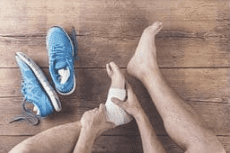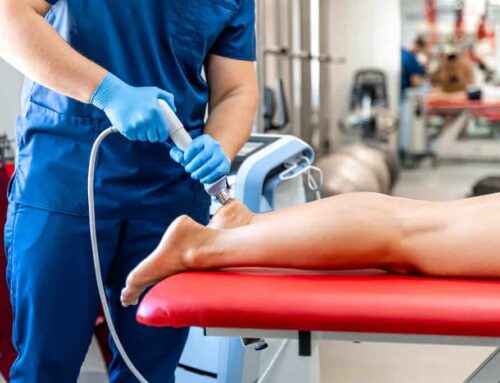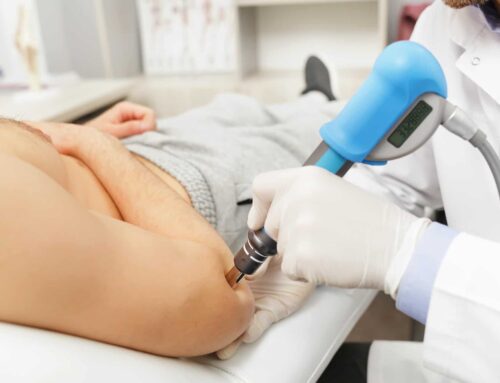Few things are feared more in the running community than plantar fasciitis. A diagnosis of plantar fasciitis could mean up to 1 year of recovery, much of which could involve avoidance of any running whatsoever – making it one of the lengthiest recoveries of any form of running injury.
So what is plantar fasciitis and why is it so slow to heal? The plantar fascia is a dense band of collagen fibers that runs from the heel to the toes (no pun intended). Plantar fasciitis literally means inflammation of these fibers; however, the chronic condition has been found to be more of a degenerative than inflammatory process. The purpose of the plantar fascia is to tighten with extension of the big toe, such as during push-off while walking or running, to maintain the shape of the arch. The plantar fascia allows the foot to serve as a rigid lever during every step of a run to assist in forward propulsion.
Causes:
There are many potential causes of plantar fasciitis. While not an exhaustive list, the following are fairly typical:
-
Excessive stress on the plantar fascia from a structural abnormality of the foot (typically an overly pronated or mobile foot posture, but may also occur in those with a more rigid and supinated foot).
-
A sudden increase in mileage, speed work, or hill training.
-
Adjustments in foot strike pattern from heel to mid or forefoot strike, or switching shoes (e.g.. from traditional to minimalist)
-
General core or lower extremity strength deficits
When you break it down, running is essentially a series of repeated hops from one leg to the other. With each step, the body experiences an impact force of about 2-3 times its weight. Over time with repeated stress, micro-tears occur in the fascia as it continues to act as a lever for propulsion. These micro-tears and resultant inflammation (the body’s mechanism for healing) are normal and generally beneficial due to the rebuilding process resulting in a stronger structure. The problem arises when these tissues are not allowed adequate recovery time for the healing process to be fully completed. Runners tend to be especially guilty of this crime – minor aches and pains often go unaddressed until they become major aches and pains.
Symptoms:
So what are the typical symptoms of plantar fasciitis? Individuals may experience increased foot and heel pain at the beginning of a run, which decreases as the run continues. Symptoms will often be worse when barefoot or wearing shoes with minimal support. Pain may also be worse after being on one’s feet, either standing or walking, for several hours. The classic and most common sign of plantar fasciitis is severe pain starting with one’s first step out of bed in the morning, in the heel, arch of the foot, or both. If a runner is experiencing these symptoms, a consultation with a physical therapist may be a good place to start. A consultation is important for two reasons. First, it can help to identify that the injury actually is plantar fasciitis and not another condition masking itself as plantar fasciitis. Secondly, a consultation will determine the individual circumstances surrounding the injury, to ensure that whatever approach is used to address the issue ultimately decreases the chances of it returning. The following are general guidelines for beginning to heal the classic case of plantar fasciitis:
-
Wear proper footwear. Avoid flip-flops and other unsupportive shoes throughout your day.
-
Alter training. Cross-training in the pool or on the bike will help unload the stressed tissues, while continued running will likely increase overall recovery time.
-
Freeze a water bottle and roll the foot over it to alleviate pain. Do not press too hard, and do not use this as a method to massage, as this could increase damage.
-
Relieve tension in the calf and hamstring muscles to help reduce stress further down the leg. This can be done with static stretches of the back of the leg, or utilizing a foam roll to reduce myofascial tension and increase overall mobility
-
Strengthen small foot muscles with exercises such as single leg balance, toe curls using a towel, and/or walking or balancing on an unstable surface such as an exercise mat. Care needs to be taken to maintain a good arch while performing these exercises as allowing your foot to collapse may stress the plantar fascia.
-
Modalities for pain relief and healing: studies have shown trigger point dry needling and electrical stimulation to be effective in reducing pain associated with plantar fasciitis. These are techniques often utilized by physical therapists.
-
Most importantly, fix the cause of the faulty pattern that ultimately caused pain. Again, a physical therapist can assist with identifying and changing training errors, faulty biomechanics, and muscle imbalances.
Treatment:
Overall, the best treatment for this annoying and stubborn issue is prevention. Slow progression of mileage, speed work, and hill training, and/or a gradual change to new footwear or foot-strike pattern, are extremely important and largely within a runner’s control as a preventative measure. It is generally suggested to increase mileage by no more than 10% per week, and speed and hill work should begin with one time per week and progress up to two-three sessions per week. When making a large change in footwear or attempting a new foot-strike pattern, it is suggested that a runner spends as little as ¼ mile (during an easy run) in that new shoe wear or pattern for the first week, and increase by ¼ mile each week following. As noted earlier, evaluation by a physical therapist can be an important part of both prevention and recovery processes, identifying potential risk factors and targeting areas for improvements in a runner’s strength and mobility. That includes the possibility of a running analysis performed by a physical therapist, all with the goal of helping runners get back on track with healthy, consistent training.
Important Note:
The above recommendations are general and may not be applicable to or appropriate for an individual runner’s specific injury. Without a professional evaluation, diagnosis and guidance it is not recommended to begin a rehabilitation program, as the condition may worsen. Please consult a local physical therapist to determine the appropriate treatment progression.






